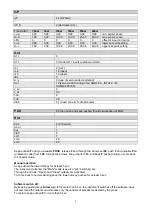
11 • MANUAL TUNING
A) Enter the setpoint at its working value.
B) Set the proportional band at 0.1% (with on-off type setting).
C) Switch to automatic and observe the behavior of the variable. It will be similar to that in the figure:
D) The PID parameters are calculated s follows: Proportional band
Peak
P.B.= ---------------------------------------- x 100
(V max - V min)
(V max - V min) is the scale range.
Integral time: It = 1.5 x T
Derivative time: dt = It/4
E) Switch the unit to manual, set the calculated parameters. Return to PID action by setting
the appropriate relay output cycle time, and switch back to Automatic.
F) If possible, to optimize parameters, change the setpoint and check temporary response.
If an oscillation persists, increase the proportional band. If the response is too slow, reduce
it.
Process
Variable
Time
T
Peak
13 • SOFTWARE ON / OFF SWITCHING FUNCTION
How to switch the unit OFF: hold down the “F” and “Raise” keys simultaneously for 5 seconds to deactivate the unit, which will go to the OFF state while
keeping the line supply connected and keeping the process value displayed. The SV display is OFF.
All outputs (alarms and controls) are OFF (logic level 0, relays de-energized) and all unit functions are disabled except the switch-on function and digital
communication.
How to switch the unit ON: hold down the “F” key for 5 seconds and the unit will switch OFF to ON. If there is a power failure during the OFF state, the unit
will remain in OFF state at the next power-up (ON/OFF state is memorized).
The function is normally enabled, but can be disabled by setting the parameter Prot = Prot +16.
SET GRADIENT: if set to ≠0, the setpoint is assumed equal to PV at power-on and auto/man switchover. With gradient set, it reaches the local setpoint.
Every variation in setpoint is subject to a gradient.
The set gradient is inhibited at power-on when self-tuning is engaged.
If the set gradient is set to ≠0, it is active even with variations of the local setpoint.
The control setpoint reaches the set value at the speed defined by the gradient.
12 • SET GRADIENT
The function works for single output systems (heating or cooling). The self-tuning action calculates optimum control parameter values during process
startup. The variable (for example, temperature) must be that assumed at zero power (room temperature).
The controller supplies maximum power until an intermediate value between starting value and setpoint is reached, after which it zeros power.
PID parameters are calculated by measuring overshoot and the time needed to reach peak. When calculations are finished, the system disables
automatically and the control proceeds until the setpoint is reached.
How to activate self-tuning:
A. Activation at power-on
1. Set the setpoint to the required value
2. Enable selftuning by setting the Stun parameter to 2 (CFG menu)
3. Turn off the instrument
4. Make sure the temperature is near room temperature
5. Turn on the instrument again
B. Activation from keyboard
1. Make sure that key M/A is enabled for Start/Stop selftuning (code but = 6 Hrd menu)
2. Bring the temperature near room temperature
3. Set the setpoint to the required value
4. Press key M/A to activate selftuning (Attention: selftuning interrupts if the key is pressed again)
The procedure runs automatically until finished, when the new PID parameters are stored: proportional band, integral and derivative times calculated
for the active action (heating or cooling). In case of double action (heating or cooling), parameters for the opposite action are calculated by maintaining
the initial ratio between parameters (ex.: CPb = HPb * K; where K = CPb / HPb when self-tuning starts). When finished, the Stun code is automatically
cancelled.
Notes :
-The procedure does not start if the temperature is higher than the setpoint (heating control mode) or if the temperature is lower than the setpoint
(cooling control mode). In this case , the Stu code is not cancelled.
-It is advisable to eneable one of the configurable LEDs to signal selftuning status.By setting one of parameters
LED1, LED2, LED3=4 or 20 on the Hrd menu, the respective LED will be on or flashing when selftuning is active.
14 • SELF-TUNING
Peak
T
S.P.
t.a.
Time
Process
Variable
S.P. + t.a.
2
12
80379_MHW_600V-T73_06-2012_ENG
Содержание TN90
Страница 2: ......
Страница 20: ...CIB UNIGAS M039259CA 20 HYDRAULIC DIAGRAMS Fig 8 Hydraulic diagram 3ID0023 Single burner configuration...
Страница 21: ...CIB UNIGAS M039259CA 21 Fig 9 Hydraulic diagram 3ID0014 Two or more burners configuration...
Страница 34: ...CIB UNIGAS M039259CA 34...
Страница 54: ......
Страница 63: ......
Страница 64: ......
Страница 65: ...RWF50 2x RWF50 3x User manual M12922CB Rel 1 0 07 2012...
Страница 80: ...16 Note Specifications and data subject to change Errors and omissions excepted...
Страница 81: ...KM3 Modulator USER MANUAL M12927CA Rel 1 0 10 2020...
Страница 82: ...M12927CA MOUNTING 2...
Страница 106: ......
Страница 107: ......
Страница 108: ......
Страница 109: ......
Страница 110: ......
Страница 111: ......
Страница 112: ......
















































